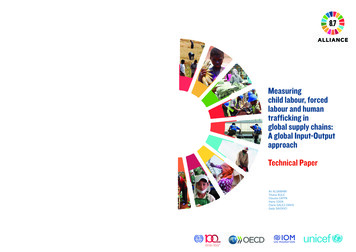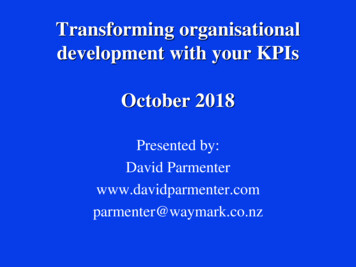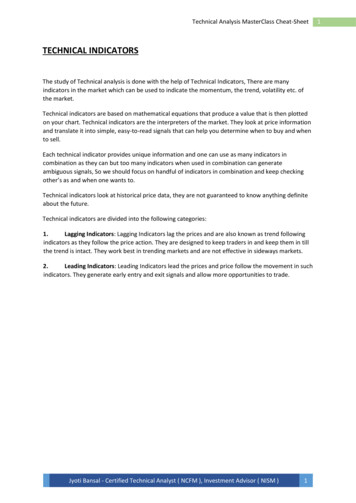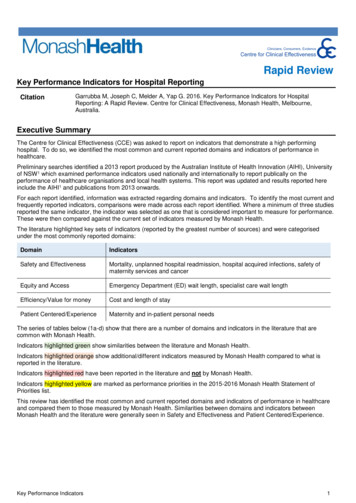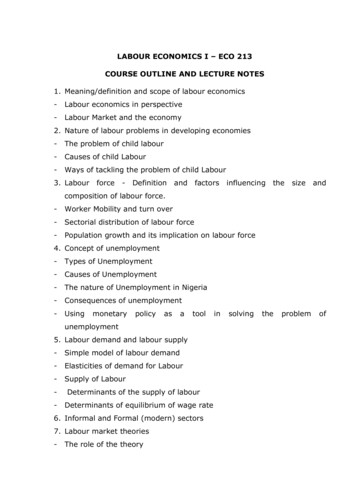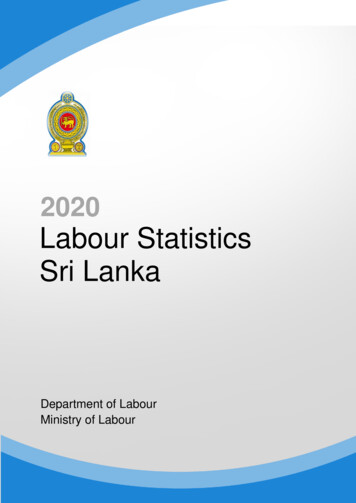
Transcription
KEY INDICATORSOF THE LABOUR MARKETNinth edition
Key Indicators of the Labour Market (KILM), Ninth editionKILM 1.Labour force participation rateKILM 2.Employment-to-population ratioKILM 3.Status in employmentKILM 4.Employment by sectorKILM 5.Employment by occupationKILM 6.Part-time workersKILM 7.Hours of workKILM 8.Employment in the informal economyKILM 9.UnemploymentKILM 10.Youth unemploymentKILM 11.Long-term unemploymentKILM 12.Time-related underemploymentKILM 13.Persons outside the labour forceKILM 14.Educational attainment and illiteracyKILM 15.Wages and compensation costsKILM 16.Labour productivityKILM 17. Poverty, income distribution, employment by economic classand working poverty
KeyIndicatorsof the LabourMarketNinth editionINTERNATIONAL LABOUR OFFICE · GENEVA
Copyright International Labour Organization 2016First published 2016Publications of the International Labour Office enjoy copyright under Protocol 2 of the Universal Copyright Convention. Nevertheless, short excerptsfrom them may be reproduced without authorization, on condition that the source is indicated. For rights of reproduction or translation, applicationshould be made to ILO Publications (Rights and Licensing), International Labour Office, CH-1211 Geneva 22, Switzerland, or by email: rights@ilo.org.The International Labour Office welcomes such applications.Libraries, institutions and other users registered with a reproduction rights organization may make copies in accordance with the licences issued tothem for this purpose. Visit www.ifrro.org to find the reproduction rights organization in your country.ILOKey Indicators of the Labour Market, Ninth editionGeneva, International Labour Office, 2016Book and interactive softwareStatistical table, labour market, employment, unemployment, labour force, labour cost,wages, labour mobility, labour productivity, poverty, statistical analysis, comparison,trend, developed country, developing country. 13.01.2ISBN: 978-92-2-130121-9 (print)ISBN: 978-92-2-030122-7 (PDF, Multilingual online edition) ILO Cataloguing in Publication DataThe designations employed in ILO publications, which are in conformity with United Nations practice, and the presentation of material therein do notimply the expression of any opinion whatsoever on the part of the International Labour Office concerning the legal status of any country, area orterritory or of its authorities, or concerning the delimitation of its frontiers.The responsibility for opinions expressed in signed articles, studies and other contributions rests solely with their authors, and publication does notconstitute an endorsement by the International Labour Office of the opinions expressed in them.Reference to names of firms and commercial products and processes does not imply their endorsement by the International Labour Office, and anyfailure to mention a particular firm, commercial product or process is not a sign of disapproval.ILO publications and digital products can be obtained through major booksellers and digital distribution platforms, or ordered directly from ilo@turpindistribution.com. For more information, visit our website: www.ilo.org/publns or contact ilopibs@ilo.org.This publication was produced by the Document and PublicationsProduction, Printing and Distribution Branch (PRODOC) of the ILO.Graphic and typographic design, layout and composition, proofreading,printing, electronic publishing and distribution.PRODOC endeavours to use paper sourced from forests managedin an environmentally sustainable and socially responsible manner.Code: DTP-JMB-CORR-REPRO
PrefaceThis 9th edition of the Key Indicators of theLabour Market (KILM) is being issued by the ILODepartment of Statistics for the first time. Theseries dates back to 1999 and was previouslypublished by the ILO’s Employment Sector. Aspart of the ILO reorganization in 2012, theDepartment of Statistics was mandated to consolidate all existing ILO statistical databases intoILOSTAT, the successor to LABORSTA and otherdatabases published in the past by the ILO.ILOSTAT is the largest repository of labour statistics in the world, covering all dimensions ofdecent work.The KILM builds on the data reported bycountries to ILOSTAT and is enriched by externalstatistical sources from other organizationsincluding Eurostat, OECD, UNESCO and the WorldBank. It relies on internationally comparable dataderived from statistical standards agreed by theInternational Conference of Labour Statisticians.Indicators in the database are disaggregatedwherever possible, with the goal of identifyingkey trends and priority groups for labour marketinterventions.The KILM is a user-friendly and easy-tounderstand database, containing 17 indicatorsthat capture the most important aspects of theworld’s labour markets. In a joint collaborationwith the ILO Research Department, it alsoincludes global, regional and national estimatesfor selected indicators. These estimates areexplicitly identified in the database and followmethodologies that are reviewed and improvedwith the release of each edition.The publication of this edition occurs at anopportune and important time, as the globalcommunity has just adopted the 2030 Agenda forSustainable Development. The Agenda calls for a“data revolution” to strengthen the productionand dissemination of statistics in all domains inorder to better understand developments at thenational, regional and global levels and therebyenable better informed policy-making.The indicator framework to track progress onthe Sustainable Development Goals (SDGs) iscurrently being discussed by countries and theinternational organizations with a goal tocomplete the work by the end of 2016.The framework will build on existing indicators and willalso embrace the new ones.Inclusive and sustainable economic growthand full and productive employment and decentwork for all are the overarching objective ofGoal 8 of the Agenda. Many of the indicators onkey aspects of decent work will build on existingones and databases like KILM will help to setbenchmarks and to monitor labour marketsaround the world.This edition of the KILM also providesthematic discussions of the educational level ofthe labour force and unemployment. It analysestrends in the share of youth who are not inemployment, education or training, the so-calledNEETs. Reducing the size of this group is aspecific target within Goal 8 of the SDGs.There are many organizations and colleagueswho are acknowledged below but I want to especially thank the producers of the data reportedhere: national statistical offices, ministries oflabour and other national institutions which diligently, carefully, and often with scarce resources,produce each survey, registry, census and otherstatistical sources to shed light on the world ofwork, carefully following international definitionsand standards and the Fundamental Principles ofOfficial Statistics.Rafael Diez de MedinaChief Statistician andDirector,Department of StatisticsInternational Labour Office
Table of contentsPreface �. . . . . . . .vSummary of KILM 9th Edition �. . . . .5Guide to understanding the �.7The history of the KILM . . . . . . . . . . . . . . . . . . . . . . . . . . . . . . . . . . . . . . . . . . . . . . . . . . . . . . . . . . . . . . . . . . .7The role of the KILM in labour market analysis . . . . . . . . . . . . . . . . . . . . . . . . . . . . . . . . . . . . . . . . . . . . . . . . .7Labour market analyses using multiple KILM indicators . . . . . . . . . . . . . . . . . . . . . . . . . . . . . . . . . . . . . . . . . . .10KILM organization and coverage . . . . . . . . . . . . . . . . . . . . . . . . . . . . . . . . . . . . . . . . . . . . . . . . . . . . . . . . . . . . .11Information repositories and methodological information . . . . . . . . . . . . . . . . . . . . . . . . . . . . . . . . . . . . . . . . .12Summary of the 17 ILO Key Indicators of the Labour Market . . . . . . . . . . . . . . . . . . . . . . . . . . . . . . . . . . . . . .14KILM electronic versions . . . . . . . . . . . . . . . . . . . . . . . . . . . . . . . . . . . . . . . . . . . . . . . . . . . . . . . . . . . . . . . . . . .20References . . . . . . . . . . . . . . . . . . . . . . . . . . . . . . . . . . . . . . . . . . . . . . . . . . . . . . . . . . . . . . . . . . . . . . . . . . . . . .20Education and labour markets: Analysing global patterns with the KILM . . . . . . . . . . . . .231. Introduction . . . . . . . . . . . . . . . . . . . . . . . . . . . . . . . . . . . . . . . . . . . . . . . . . . . . . . . . . . . . . . . . . . . . . . . . . .232. Global trends by indicator . . . . . . . . . . . . . . . . . . . . . . . . . . . . . . . . . . . . . . . . . . . . . . . . . . . . . . . . . . . . . . .242.1. Labour force distribution by level of educational attainment . . . . . . . . . . . . . . . . . . . . . . . . . . . . . . .242.2. Unemployment distribution by level of educational attainment . . . . . . . . . . . . . . . . . . . . . . . . . . . . .272.3. Unemployment rate by level of educational attainment . . . . . . . . . . . . . . . . . . . . . . . . . . . . . . . . . . .282.4. Share of youth not in education, employment or training (NEET) . . . . . . . . . . . . . . . . . . . . . . . . . . .313. Impact of education on labour market outcomes . . . . . . . . . . . . . . . . . . . . . . . . . . . . . . . . . . . . . . . . . . . . .323.1. Unemployment and education . . . . . . . . . . . . . . . . . . . . . . . . . . . . . . . . . . . . . . . . . . . . . . . . . . . . . . .323.2. Labour productivity and education . . . . . . . . . . . . . . . . . . . . . . . . . . . . . . . . . . . . . . . . . . . . . . . . . . .353.3. Employment-to-population ratio and education . . . . . . . . . . . . . . . . . . . . . . . . . . . . . . . . . . . . . . . . .373.4. Share of employees and education . . . . . . . . . . . . . . . . . . . . . . . . . . . . . . . . . . . . . . . . . . . . . . . . . . .374. The current situation in 12 selected countries . . . . . . . . . . . . . . . . . . . . . . . . . . . . . . . . . . . . . . . . . . . . . . .374.1Data for latest year available on the four selected indicators . . . . . . . . . . . . . . . . . . . . . . . . . . . . . . . .374.2. Educational attainment compared to other key labour market indicators . . . . . . . . . . . . . . . . . . . . .414.3. Remaining gaps in education . . . . . . . . . . . . . . . . . . . . . . . . . . . . . . . . . . . . . . . . . . . . . . . . . . . . . . . .444.3.1. Persistent low levels of educational attainment . . . . . . . . . . . . . . . . . . . . . . . . . . . . . . . . . . . .444.3.2. Disparities between population groups . . . . . . . . . . . . . . . . . . . . . . . . . . . . . . . . . . . . . . . . . .454.3.3. Attention to qualitative factors and field of study . . . . . . . . . . . . . . . . . . . . . . . . . . . . . . . . . .475. Conclusion . . . . . . . . . . . . . . . . . . . . . . . . . . . . . . . . . . . . . . . . . . . . . . . . . . . . . . . . . . . . . . . . . . . . . . . . . . .47References . . . . . . . . . . . . . . . . . . . . . . . . . . . . . . . . . . . . . . . . . . . . . . . . . . . . . . . . . . . . . . . . . . . . . . . . . . . . . .47Annex . . . . . . . . . . . . . . . . . . . . . . . . . . . . . . . . . . . . . . . . . . . . . . . . . . . . . . . . . . . . . . . . . . . . . . . . . . . . . . . . .48
VIIIContentsKILM 1.Labour force participation . . . . . . . . . . . . . .51KILM 2.Employment-to-population �. . . . . . . . . . . . .55KILM 3.Status in employment . . .61KILM 4.Employment by sector . . . . . . . . . . . . . . . . . . . . . . . . . . . . . . . . . . . . . . . . . . . . . . . . . . . . . . . . . . . . . . . . . . . . .65KILM 5.Employment by occupation . . . . . . . . . . . . . .69KILM 6.Part-time workers . . . . . .73KILM 7.Hours of �. . . . . . . . . .77KILM 8.Employment in the informal . . . . . . . . .83KILM . . . . . . . . . . . .89KILM 10.Youth . . . . . . .97KILM 11.Long-term . . . .101KILM 12.Time-related underemployment . . . . . . . . . . .105KILM 13.Persons outside the labour �. . . . . . . . . . . . .111KILM 14.Educational attainment and illiteracy . . . . . . .113KILM 15.Wages and compensation �. . . . . . . . . . . . . .119KILM 16.Labour . . . . . . . . .131KILM 17.Poverty, income distribution, employment by economic class and working �. . . . . . .135List of re of the labour force with primary or less than primary level educational attainment (%) . . . . . . . . . . . . .Share of the labour force with tertiary level educational attainment (%) . . . . . . . . . . . . . . . . . . . . . . . . . . . . . .Share of unemployed with tertiary level educational attainment (%) . . . . . . . . . . . . . . . . . . . . . . . . . . . . . . . . .Share of young unemployed with tertiary level educational attainment (%) . . . . . . . . . . . . . . . . . . . . . . . . . . .Unemployment rate of persons with tertiary level educational attainment (%) . . . . . . . . . . . . . . . . . . . . . . . . .Unemployment rate of persons with primary or less than primary level educational attainment (%) . . . . . . . .Share of youth not in education, employment or training (%) . . . . . . . . . . . . . . . . . . . . . . . . . . . . . . . . . . . . . .Share of labour force and unemployed with tertiary level of educational attainment (%) . . . . . . . . . . . . . . . . .Share of labour force and unemployment rate for persons with tertiary level of educational attainment (%) . .Tertiary level of educational attainment and labour productivity (PPP US ) . . . . . . . . . . . . . . . . . . . . . . . . . . .Employment-to-population ratio and labour force with tertiary level educational attainment . . . . . . . . . . . . . .Share of employees in total employment, and share of labour force with tertiary levelof educational attainment . . . . . . . . . . . . . . . . . . . . . . . . . . . . . . . . . . . . . . . . . . . . . . . . . . . . . . . . . . . . . . . . . .Labour force by level of educational attainment . . . . . . . . . . . . . . . . . . . . . . . . . . . . . . . . . . . . . . . . . . . . . . . . .Unemployment distribution by level of educational attainment . . . . . . . . . . . . . . . . . . . . . . . . . . . . . . . . . . . . .Unemployment rate by level of educational attainment . . . . . . . . . . . . . . . . . . . . . . . . . . . . . . . . . . . . . . . . . . .Share of youth (aged 15 24) not in education, employment or training, by sex . . . . . . . . . . . . . . . . . . . . . . . .Tertiary level educational attainment and unemployment . . . . . . . . . . . . . . . . . . . . . . . . . . . . . . . . . . . . . . . . .Tertiary level educational attainment and unemployment rate . . . . . . . . . . . . . . . . . . . . . . . . . . . . . . . . . . . . .Tertiary level educational attainment and labour productivity . . . . . . . . . . . . . . . . . . . . . . . . . . . . . . . . . . . . . .Employment-to-population ratio and educational attainment . . . . . . . . . . . . . . . . . . . . . . . . . . . . . . . . . . . . . . .Share of employees and educational attainment . . . . . . . . . . . . . . . . . . . . . . . . . . . . . . . . . . . . . . . . . . . . . . . . .Male and female unemployment rates by educational attainment . . . . . . . . . . . . . . . . . . . . . . . . . . . . . . . . . . .Youth and adult unemployment rates by educational attainment . . . . . . . . . . . . . . . . . . . . . . . . . . . . . . . . . . . t of boxes1a.1b.1c.1.1.2.4.5a.5b.7.Labour market statistics at the ILO . . . . . . . . . . . . . . . . . . . . . . . . . . . . . . . . . . . . . . . . . . . . . . . . . . . . . . . . . . .ILO methodology for producing global and regional estimates of labour market indicators . . . . . . . . . . . . . . .Resolution concerning statistics of work, employment and labour underutilization . . . . . . . . . . . . . . . . . . . . .Data on the labour market and education: Statistical issues . . . . . . . . . . . . . . . . . . . . . . . . . . . . . . . . . . . . . . . .Resolution concerning statistics of work, employment and labour underutilization,adopted by the 19th International Conference of Labour Statisticians, October 2013 [relevant paragraphs] . .International Standard Industrial Classification of All Economic Activities . . . . . . . . . . . . . . . . . . . . . . . . . . . . .International Standard Classifications of Occupations: major groups . . . . . . . . . . . . . . . . . . . . . . . . . . . . . . . . .International Standard Classification of Occupations, 2008 . . . . . . . . . . . . . . . . . . . . . . . . . . . . . . . . . . . . . . . .Resolution concerning the measurement of working time, adopted by the 18th InternationalConference of Labour Statisticians, November–December 2008 . . . . . . . . . . . . . . . . . . . . . . . . . . . . . . . . . . . .81319245866717280
Table of contents8a.8b.9.12a.12b.15a.15b.15c.Avoiding confusion in terminologies relating to the informal economy . . . . . . . . . . . . . . . . . . . . . . . . . . . . . . .Timeline of informality as a statistical concept . . . . . . . . . . . . . . . . . . . . . . . . . . . . . . . . . . . . . . . . . . . . . . . . . .Resolution concerning statistics of work, employment and labour underutilization,adopted by the 19th International Conference of Labour Statisticians, October 2013 [relevant paragraphs] . .Resolution concerning the measurement of underemployment and inadequate employmentsituations, adopted by the 16th International Conference of Labour Statisticians,October 1998 [relevant paragraphs] . . . . . . . . . . . . . . . . . . . . . . . . . . . . . . . . . . . . . . . . . . . . . . . . . . . . . . . . . .Resolution concerning statistics of work, employment and labour underutilization,adopted by the 19th International Conference of Labour Statisticians,October 2013 [relevant paragraphs] . . . . . . . . . . . . . . . . . . . . . . . . . . . . . . . . . . . . . . . . . . . . . . . . . . . . . . . . . .The ILO’s Global Wage Report . . . . . . . . . . . . . . . . . . . . . . . . . . . . . . . . . . . . . . . . . . . . . . . . . . . . . . . . . . . . . . .Resolution concerning statistics of labour cost, adopted by the 11th International Conferenceof Labour Statisticians, October 1966 [relevant paragraphs] . . . . . . . . . . . . . . . . . . . . . . . . . . . . . . . . . . . . . . . .Resolution concerning an integrated system of wages statistics, adopted by the 12th InternationalConference of Labour Statisticians, October 1973 [relevant paragraphs] . . . . . . . . . . . . . . . . . . . . . . . . . . . . . . IX868795108109126127128
Summary of KILM 9th EditionThe KILM has becomea cornerstone ofinformation for thoseconcerned withthe world of work.The first edition of the Key Indicators of the Labour Market (KILM)was released in 1999. It has since become a leading product of theInternational Labour Office (ILO) and is used daily by researchers andpolicy-makers throughout the world.At the national level, statistical information is generally gathered andanalysed by statistical services and ministries. At the global level, the ILOplays a vital role in assembling and disseminating labour market information and analysis to the world community. ILOSTAT, the ILO consolidateddatabase, is the biggest repository of labour statistics in the world. Dueto its complexity and wide range of indicators, ILOSTAT includes subsetsof databases which provide more in-depth analysis for key indicators.This is the case for the KILM, which is based in large part on data fromILOSTAT, augmented by data from other international repositories andwith estimates and projections carried out by the ILO ResearchDepartment and Department of Statistics. A key aim of the KILM is topresent a core set of labour market indicators in a user-friendly manner.This ninth editionof the KILM strengthensthe ILO’s efforts tosupport measurementof national progresstowards the new SDGof “promotingsustained, inclusiveand sustainableeconomic growth,full and productiveemployment and decentwork for all”.The KILM also serves as a source of national data for measuringprogress towards Sustainable Development Goal 8 (SDG 8), to “promotesustained, inclusive and sustainable economic growth, full and productive employment and decent work for all”. For example, GDP per capitaand GDP growth (KILM A), the share of informal employment in nonagricultural employment (KILM 8) and the share of youth not in education, employment or training (NEET, KILM 10c), when analysed together,can offer a rich assessment of trends and levels of decent and product ive employment in a country. While the Indicator Framework to monitor the 2030 Agenda for Sustainable Development is still under development, this set of key indicators will undoubtedly be instrumental forthis purpose.The KILM also provides valuable information on indicators relatingto other SDGs linked to employment and the labour market. For example,the statistics on poverty and income distribution contained in KILM table18a can be a very useful tool for measuring progress towards the SDG 1of “ending poverty in all its forms everywhere” and SDG 10 of “reducinginequality within and among countries”.The KILM offers timelydata and tools for thoseseeking to run theirown analysis.The KILM programme has met the primary objectives set for it in 1999,namely: (1) to present a core set of labour market indicators; and (2) toimprove the availability of the indicators to monitor new employmenttrends. But that is not all that the KILM has to offer. It has evolved into aprimary research tool that provides not only the means for analysis, i.e. thedata, but also guidance on interpretation of indicators and data trends.These contributions – including those in this KILM 9th edition, describedbelow – serve the ILO’s agenda of identifying employment challenges inorder to inform policy action that can create more decent work opportunities around the world, especially where the need is greatest.
2Summary of KILM 9th EditionSmart policy-makingrequires up-to-date andreliable labour marketinformation Defining effective labour market strategies at the country level requiresfirst and foremost the collection, dissemination and assessment of up-todate and reliable labour market information.1 Once policies and strategyare decided, continued gathering and analysis of information are essential to monitor progress towards goals and to adjust policies whereneeded. Labour market information and analysis is an essential foundation for the development of integrated strategies to promote fundamental principles and rights at work, productive employment, social protection and dialogue between the social partners, as well as to address thecross-cutting themes of gender and development.This is where the KILMcomes in. such as thatprovided in the KILM.The KILM is a collection of 17 “key” indicators of the labour market,covering employment and other variables relating to employment(status, economic activity, occupation, hours of work, etc.), employmentin the informal economy, unemployment and the characteristics of theunemployed, underemployment, education, wages and compensationcosts, labour productivity and working poverty. Taken together, theKILM indicators provide a strong basis for assessing and addressing keyquestions related to productive employment and decent work.This edition highlightscurrent labour markettrends:This ninth edition of the KILM offers a series of noteworthy findings,some excerpts of which are presented here:The world’s labourforce is becoming moreand more highlyeducated, which couldsupport increasedproductivity. The educational level of the world’s labour force is improving. In 62out of 64 countries with available data spanning the past 15 years, theshare of the labour force with a tertiary education increased. In allbut three of these countries, the share of the labour force that hadattained only primary or less than primary educational level declined– with significant improvements seen in many low income, lowermiddle income and upper middle income economies. An increasing proportion of the labour force with tertiary leveleducation is associated with higher levels of labour productivity, andso these favourable education trends could facilitate an expansion inproduction of higher value added goods and services and fasterproductivity growth, thereby supporting economic growth anddevelopment.Education is not alwayseffective in protectingagainst unemployment. In 67 of the 93 countries for which data are available, people withtertiary education are less likely to be unemployed than people withlower levels of education. Yet, while higher levels of education arefound to protect workers from unemployment in most high incomecountries, among upper middle income economies the situation ismore mixed, and in low income and lower middle income econ omies, people with high levels of education tend to be more likely tobe unemployed. In these developing economies, there is a clearmismatch between the numbers of skilled people and of availablejobs matching their competencies and expectations.Unemploymentremains elevated inmost countries. Out of 112 countries with comparable KILM unemployment ratedata, 71 (63 per cent) had higher unemployment rates in 2014 (or theclosest available year) than in 2007.The median unemployment rateacross these 112 countries increased from 6.4 per cent in 2007 to7.2 per cent in 2014.1For examples of how the KILM can be used when formulating policies, see the “Guide to understanding the KILM”.
Summary of KILM 9th EditionWide productivitygaps remain, withdifferences in levelsof industrializationplaying a key rolein determiningproductivity levels.Productivityis growing fastestin middle incomeeconomies.Favourable labourmarket trendsin middle incomeeconomies havehelped reduce globalpoverty. High income economies saw the number of unemployed increase by16.2 million between 2007 and 2009, accounting for 56 per cent ofthe total global increase in unemployment during the global financialand economic crisis. However, since 2009, the number of unemployed in high income economies has declined by 5.7 million,whereas the number of unemployed in each of the other incomegroups continues to grow. The average worker in a high income economy currently produces62 times the annual output of the average worker in a low incomeeconomy and ten times that of the average worker in a middle incomeeconomy (based on productivity figures in constant 2005 US ). Economic structure is closely related to these productivity differences. In low income countries, more than two-thirds of all workersare employed in the agricultural sector – often in low productivity,subsistence activities – and only 9 per cent are employed in industry.In middle income economies, less than one-third of workers areemployed in agriculture, while 23 per cent of workers are employedin the industrial sector. Middle income economies have accounted for nearly all (97 per cent)of the global growth in industrial employment since 2000. Manufacturing employment in high income economies has declined by5.2 million since 2000, while in middle income economies it hasgrown by 195 million. In line with this rapid industrialization, middle income economieshave registered the fastest productivity growth
Production, Printing and Distribution Branch (PRODOC) of the ILO. Graphic and typographic design, layout and composition, proofreading, printing, electronic publishing and distribution. PRODOC endeavours to use paper sourced from forests managed in an environmentally sustainable and socially responsible manner. Code: DTP-JMB-CORR-REPRO



